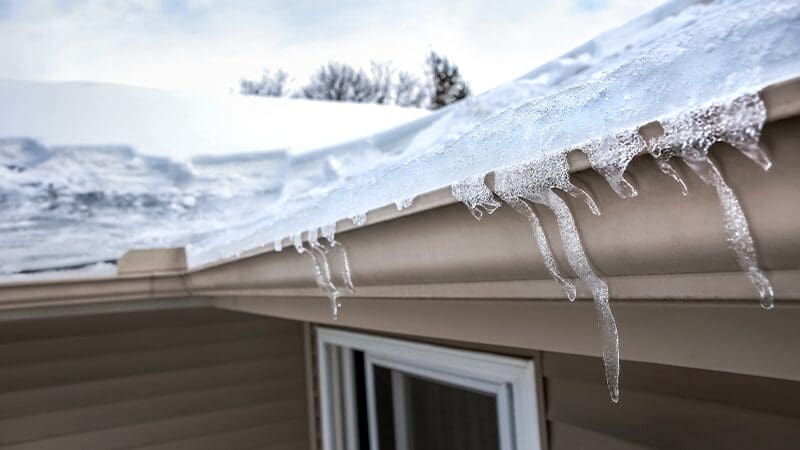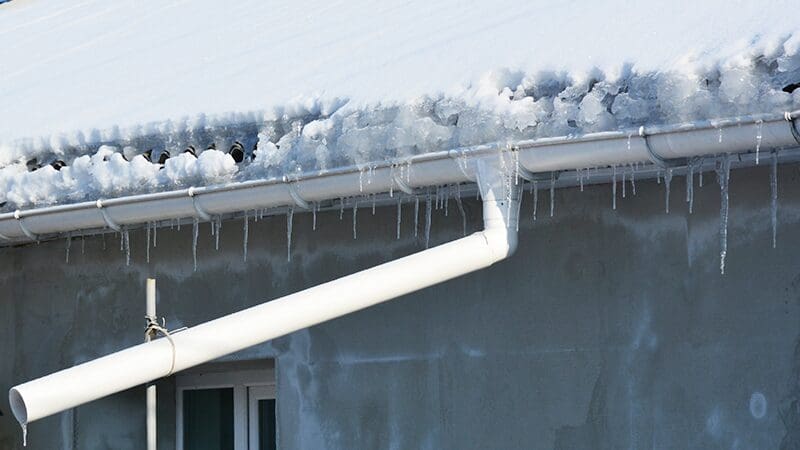Winter’s a festive time of year, but it poses some serious threats to your roof. And all of it has to do with the freeze-thaw cycle.
Virginia Beach tends to stay warmer than more in-land Virginia cities. However, we can still reach freezing temperatures at night. And that’s the problem. Rain or water can slip into vulnerabilities in your roof. Perhaps a corner of flashing is bending outwards. Perhaps one loose shingle lets water slide under more shingles.
Small cracks or gaps can trap water. Then, at night, it freezes, expanding the opening. Over the course of winter, that freeze-and-thaw cycle can gradually weaken your roof.
One major issue that can exacerbate your roof’s problems is ice dams.
Ice dams start with snow on your roof.
A picturesque blanket of snow covers your neighborhood. Perfect for a cozy day in, but is your roof safe?
When snow accumulates on roofs, the bottom layer of snow might melt due to heat escaping your house. That ice often refreezes at the edge of your roof. It dams up your roof, preventing snow from sliding off and stopping water from dripping down. It’s like a miniature glacier right on your roofline. When snow melts, it has no choice but to seep under shingles and into your home’s structure.
How can I prevent ice dams on my Virginia Beach Home?
- Improve attic insulation and ventilation so your roof remains at a consistent temperature. Insulation and ventilation are a bit beyond the scope of this blog. So, your best bet is to contact a local roofing company in Virginia Beach for help.
- Clean gutters and downspouts regularly to ensure proper water drainage. A lot of people forget about their gutters until it’s too late.
- Use a roof rake to remove snow accumulation, especially after heavy snowfalls.
- Seal air leaks in the attic to prevent warm air from escaping. Again, with something like that, you’ll probably need help from trusted roofing contractors in Virginia Beach.

How do I clear away ice dams on my Virginia Beach home?
Clearing away ice dams can be dangerous, not only due to the weather conditions but because of bad advice. Avoid DIY methods like using an axe, ice pick, or blowtorch. It doesn’t take a genius to see how that’s a recipe for an injury. Even if you do successfully clear away the ice with a pick or blowtorch, it can damage your roof. You might just end up needing additional roof repair services, Virginia Beach.
In our opinion, the best way to treat ice dams is to prevent them. But if you already have them, there are two routes.
Some roofing professionals use ice dam steaming. They have specialized equipment that melts the ice dams with low-pressure steam. It’s the safest and most effective option, as it doesn’t damage your roof. However, these services are not really available here. They are more prevalent in northern, colder states.
The safer DIY method is to use calcium chloride. That’s the de-icing salt people often put on roads and sidewalks. Fill tube socks with the road salt, tie off the ends, and place them vertically across the ice dam. In a day or two, they will create channels along the dam to let water drain. Be careful with the salt, as it can be corrosive to the metal components of the roof.

The best thing you can do is get regular roof inspections.
We know that you’re probably thinking, “Of course, the roofing people recommend roof inspections. It’s their job!” But how else are you going to learn the ins and outs of your roof? How else are you going to spot tiny problems before they snowball into expensive repairs?
No one expects you to know everything about your roof. That’s why you learn from the experts.
So, if you want to protect your home from hail damage or learn the best time to replace your roof, we got you covered!
